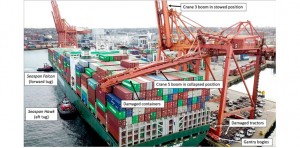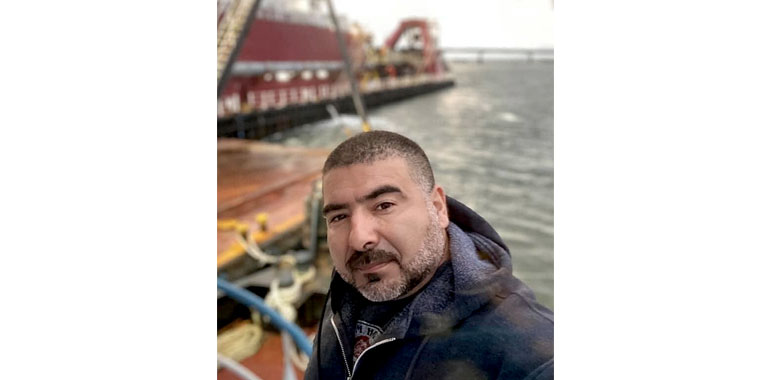
The pilot guiding a containership into the Port of Vancouver inadvertently gave opposite instructions to the tugboats assisting the ship into the terminal, Canadian authorities said, and attempts to reverse the mistake came too late.
The Panama-flagged Ever Summit struck a gantry crane and berth infrastructure on Jan. 28, 2019 at 0401 while docking at Global Container Terminals’ (GCT) Vanterm facility. The crane boom collapsed onto containers on the ship’s aft deck, and the vessel and berth were damaged.
Canada’s Transportation Safety Board (TSB) cited errant tugboat orders from the member of the B.C. Coast Pilots as a leading factor in the incident. But it was not the only one. Investigators noted the lack of terminal upgrades to account for larger containerships and the ship’s close approach to the berth that provided less margin for error.
“The vessel transited the berth approximately (33 feet) off, an approach which limited the time to respond to any deviations during the berthing maneuver,” the TSB said in its report published last fall.
The 984-foot, 7,024-TEU Ever Summit entered Vancouver Harbor at about 0320 on Jan. 28 with the B.C. Coast pilot and an observing pilot on board. The B.C. Coast pilot positioned the tugboats Seaspan Falcon and Seaspan Hawk on the port side, with Falcon forward and Hawk aft. The 6,000-hp tugs secured their lines and approached the Vanterm container terminal at about 0340.
Ever Summit made an angled approach to the terminal, a relatively common tactic but one that ran counter to docking instructions on the ship’s pilot card. That document recommended the pilot position the ship parallel to the berth and use tugboats to push it against the terminal, the TSB report said.
Regardless, Ever Summit was nearly in position at the terminal at 0359, and the pilot ordered the engines dead slow astern to reduce the ship’s speed below 1 knot. The pilot expected this would cause the stern to sheer toward the berth and he planned to use the tugboats to counter this motion. He mistakenly ordered Seaspan Falcon, at the bow, to stretch the line and back at maximum power. Seaspan Hawk at the stern was ordered to push at full power.
“As the tugs carried out the commands, the vessel’s stern rapidly sheered toward the berth,” the report said. “The master expressed concern about the sheer to the pilot, but neither the pilot nor the master identified that the tugs were assisting in the opposite direction than intended. Attempting to correct this, the pilot called for increased power on the tugs, but the sheer increased.”
The pilot’s thruster, engine and rudder orders weren’t enough to avoid hitting the terminal. Ever Summit’s flared stern hit both the berth and crane 5 positioned along the edge of the berth.
“The shoreside gantry bogies for crane 5 collapsed inward toward the terminal, and the boom fell onto the vessel,” the TSB said. “At the time of the striking, the vessel was at an angle of approximately 10 degrees from the berth face.”
The impact gashed Ever Summit’s hull at the starboard stern and crane 5 was declared a total loss. A bollard and other portside infrastructure also sustained damage. Activity at the terminal was disrupted for more than a week. Damage estimates were not available.
While the TSB identified human error as a leading cause of the incident, it also noted the need for port facility improvements to safely handle larger containerships. Testing at Vanterm in 2012 found that terminal fenders were insufficient to absorb energy from ships during docking. The report suggested this disparity has increased in the past eight years as ships have gotten larger.
The TSB also noted issues with the distance between shoreside cargo-loading equipment and the ships. The distance from the crane rail to the berth line at Vanterm is only 7 feet, the report said, “which means that even a slight angle on a vessel while berthing could cause the flare of its bow or stern to come into contact with a crane if one is in the vicinity.”
The distance between the crane rail and berth line at GCT Delta-port, another British Columbia container facility, is almost 23 feet. Deltaport also is equipped with more robust terminal fendering. In May 2019, Global Container Terminals announced a $160 million investment to modernize and upgrade Vanterm.
In a prepared statement, GCT declined to address port issues noted in the TSB report.
“We have reviewed the report previously and won’t be commenting on the investigation into the human error that led to the incident,” spokeswoman Jennifer Perih said.
The B.C. Coast Pilots did not respond to messages seeking comment on the TSB findings.

